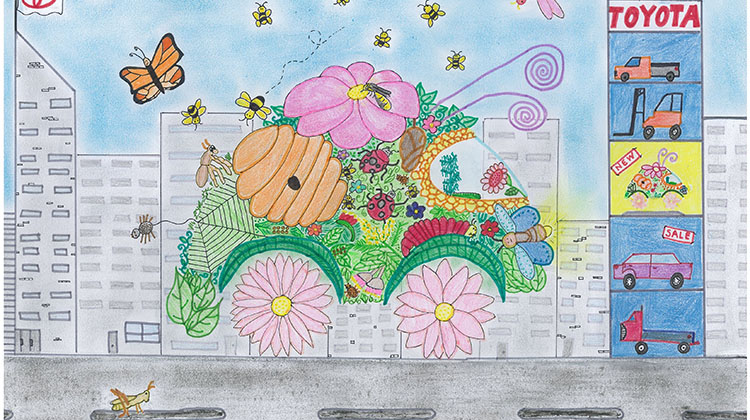Nature Insect Car wins the Toyota Dream Car Art Contest

Using vehicles that don’t pollute is a good idea but making vehicles that improve the environment is an even better one.
That’s the brilliant thinking behind eight-year-old Claudia Fields’ winning entry in the Toyota Dream Car Art Contest, the Nature Insect Car.
The entries put the rich imaginations and creative talent of young Australians on display and the work submitted was uniformly innovative, unfettered and surprising.
Claudia’s Nature Insect Car, built from plants, flowers and bugs would be great for the physical as well as the mental environment.
"Cities are very grey and have lots of concrete. If there were lots of 'Nature Insect Cars' driving around in the city there would be so much colour and nature. People living in the cities would feel so happy seeing the plants and flowers and greenery.
“The cars will make the air smell fresh and clean. The insects would have a safe home to live. Insects break down waste and bees pollenate the flowers and make honey! I live on an orchard and bees are very important to make fruit," she says.
Caludia was justifiably pleased with the win and while it’s early days yet she’s starting to think about what her future career might look like.
"I felt so proud when my Mum told me that I was the Grand Final winner for Australia! I loved making my 'Nature Insect Car' in the school holidays. It took me a long time to draw but I didn't think I would win. There were so many amazing pictures for the judges to choose from. It must be tricky for them to decide."
Claudia is interested in both science and art making her a natural for a world that will be increasingly interdisciplinary.
"I like science because I get to learn about insects and nature and the environment. I also enjoy art because you get to have lots of fun and be creative. And I love sport because I get fit and healthy. I love being outdoors."
"The Toyota Dream a Car Competition makes me want to create and design stuff. I am not exactly sure of what I want to be when I grow up. But I do think being an art or science teacher would be fun. Then I can teach children about the environment and insects and help them understand that nature is important. Maybe I can drive my "Nature Insect Car" to school?"
For Jason Kimberley the managing director of education resource Cool Australia who partnered with the competition, creativity is the driving force behind innovation and it should be fostered young, competitions like the Toyota Dream Car Art Contest are good place to start.
Kimberley sees creativity as something that needs to be instilled in teachers and students alike.
“Being a creative teacher isn’t easy, and it doesn’t happen overnight; the more we practice, the easier it becomes. Sounds sort of familiar, right? Almost as if it’s something we tell students on an almost daily basis?
“As for fostering creativity in the classroom, perhaps I can best sum this up with a story from my past experience. I once worked with a colleague who disagreed with teaching a particular topic in a Science class because, and I quote: ‘… it just raises too many questions’. What are classrooms for if not to allow students to ask questions, to be curious, to challenge ideas, and to be heard? Create a safe place for students to contribute, without fear of judgement, and indulge their curiosity,” he says.
Kimberley says that to create a STEAM-focussed curriculum, we need to look at the nature of why we teach students the way we do and shift away from a standardised exam-centric approach to a solutions-based approach. The curriculum needs to be framed within the context of creating a better planet, one in which our species can continue to thrive.
“Creativity is what we need, both in the classroom and in how we approach education as a system. It will take a great deal of creativity to break down the traditional knowledge silos we’ve decided need to be there and bring subjects together with a common goal and approach that we can be united towards.
“Teachers should find a hook to engage students – can you imagine a system where the entire curriculum has a hook and that hook is to create a better planet to live on (and that’s not even counting when we become an interplanetary species)? I can’t think of anything more noble.”